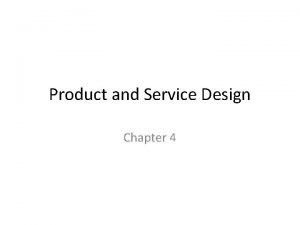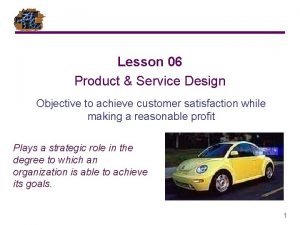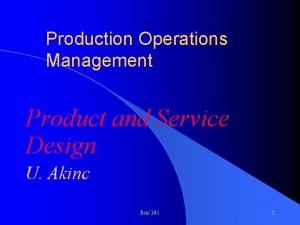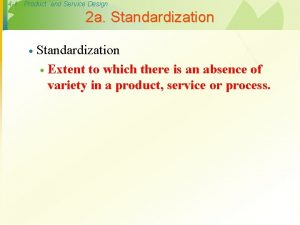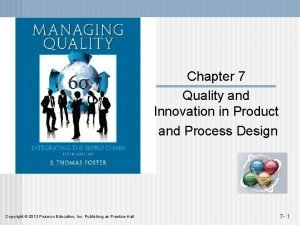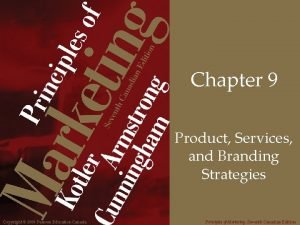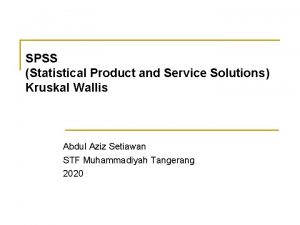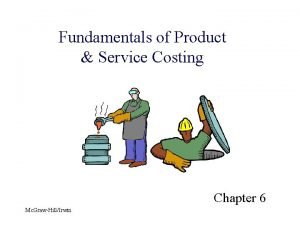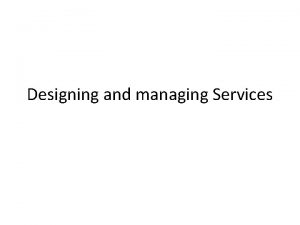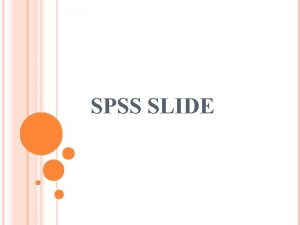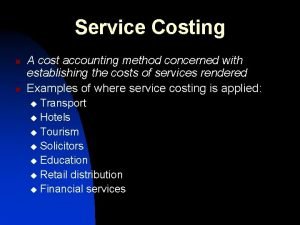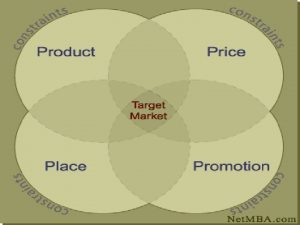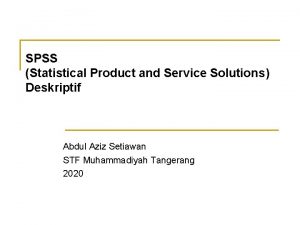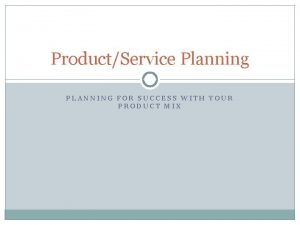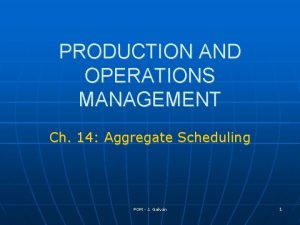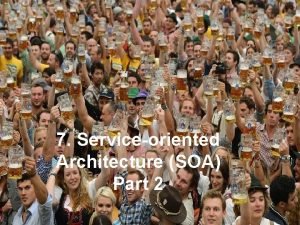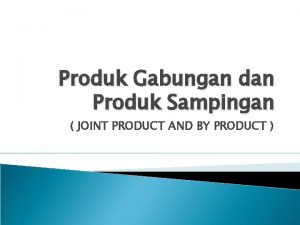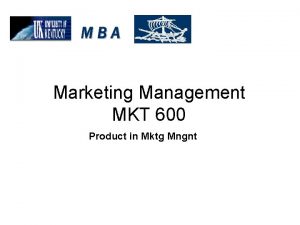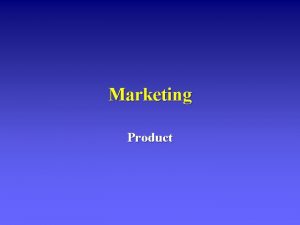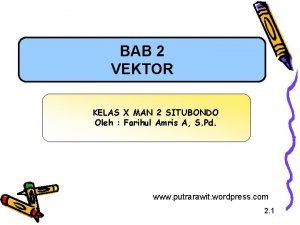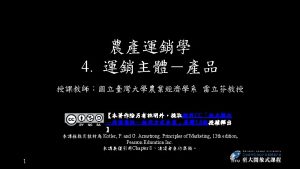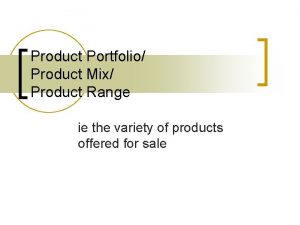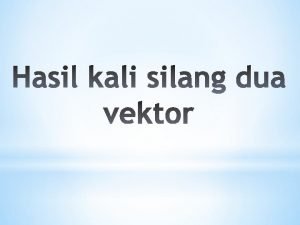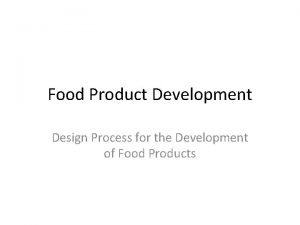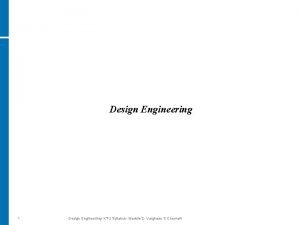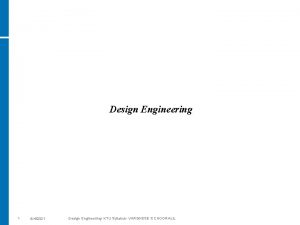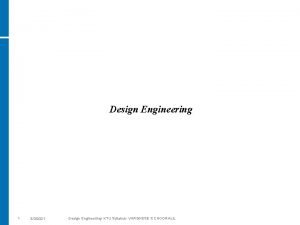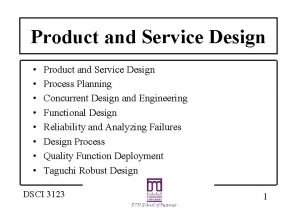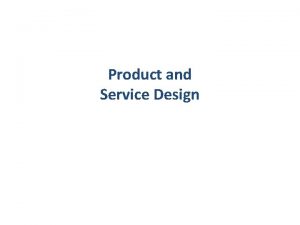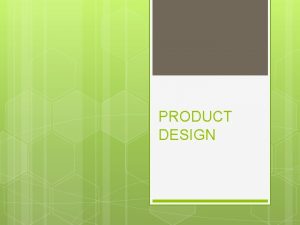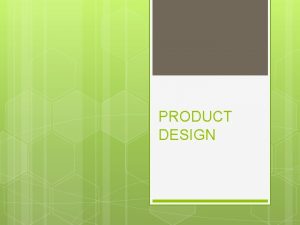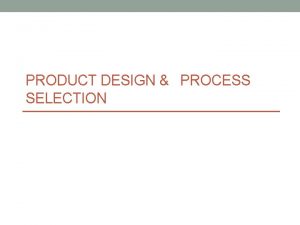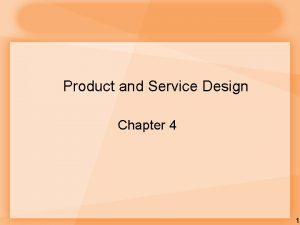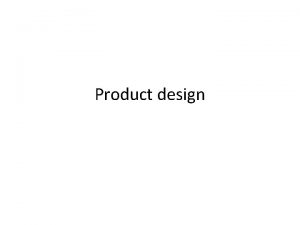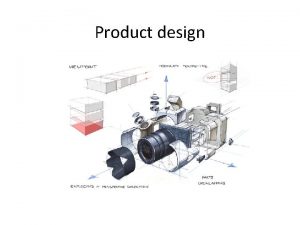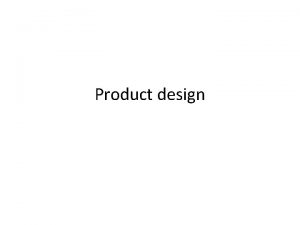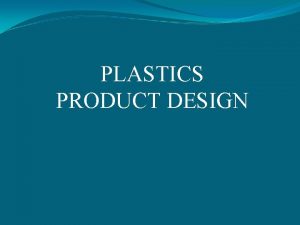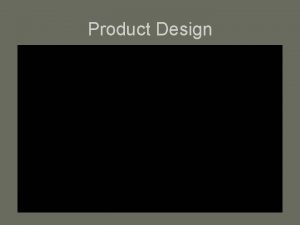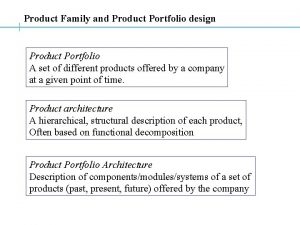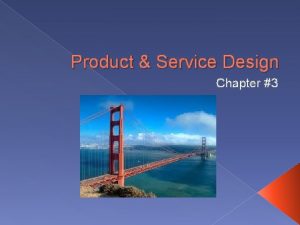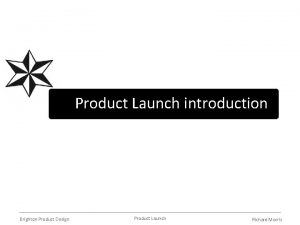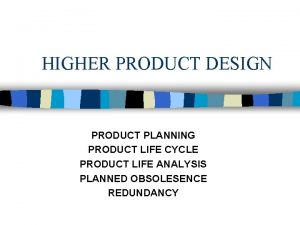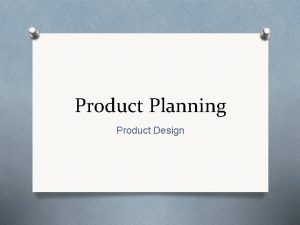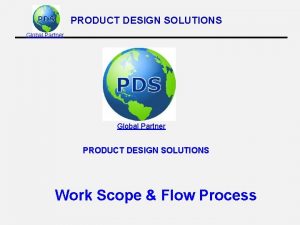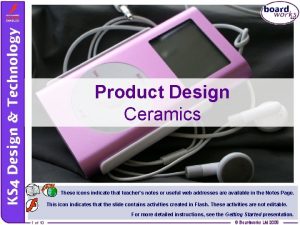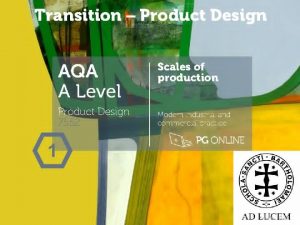Product and Service Design Chapter 4 4 1




































- Slides: 36

Product and Service Design Chapter 4 4 -1

Product or Service Design Activities 1. Translate customer wants and needs into product and service requirements 2. Refine existing products and services 3. Develop new products and services 4. Formulate quality goals 5. Formulate cost targets 6. Construct and test prototypes 7. Document specifications 4 -2

Product and Service Design § Major factors in design strategy § § § Cost Quality Time-to-market Customer satisfaction Competitive advantage Product and service design – or redesign – should be closely tied to an organization’s strategy 4 -3

Reasons for Product or Service Design § Economic § Social and demographic § Political, liability, or legal § Competitive § Cost or availability § Technological 4 -4

Objectives of Product and Service Design § Main focus § Customer satisfaction § Understand what the customer wants § Secondary focus § § § Function of product/service Cost/profit Quality Appearance Ease of production/assembly Ease of maintenance/service 4 -5

Designing For Operations § Taking into account the capabilities of the organization in designing goods and services. § Failure to take this into account can: § Reduce productivity § Reduce quality § Increase costs 4 -6

Legal, Ethical, and Environmental Issues § Legal § FDA, OSHA, IRS § Product liability § Uniform commercial code § Ethical § Releasing products with defects § Environmental § EPA 4 -7

Regulations & Legal Considerations § Product Liability - A manufacturer is liable for any injuries or damages caused by a faulty product. § Uniform Commercial Code - Products carry an implication of merchantability and fitness. 4 -8

Designers Adhere to Guidelines § Produce designs that are consistent with the goals of the company § Give customers the value they expect § Make health and safety a primary concern § Consider potential harm to the environment 4 -9

Other Issues in Product and Service Design § § § § Product/service life cycles How much standardization Mass customization Product/service reliability Robust design Degree of newness Cultural differences 4 -10

Life Cycles of Products or Services Saturation Demand Maturity Decline Growth Introduction Time 4 -11

Standardization § Extent to which there is an absence of variety in a product, service or process § Standardized products are immediately available to customers 4 -12

Advantages of Standardization § Fewer parts to deal with in inventory & manufacturing § Design costs are generally lower § Reduced training costs and time § More routine purchasing, handling, and inspection procedures § Quality is more consistent 4 -13

Advantages of Standardization (Cont’d) § Orders fillable from inventory § Opportunities for long production runs and automation § Need for fewer parts justifies increased expenditures on perfecting designs and improving quality control procedures. 4 -14

Disadvantages of Standardization § Designs may be frozen with too many imperfections remaining. § High cost of design changes increases resistance to improvements. § Decreased variety results in less consumer appeal. 4 -15

Mass Customization • Mass customization: § A strategy of producing standardized goods or services, but incorporating some degree of customization § Delayed differentiation § Modular design 4 -16

Delayed Differentiation • Delayed differentiation is a postponement tactic § Producing but not quite completing a product or service until customer preferences or specifications are known 4 -17

Modular Design Modular design is a form of standardization in which component parts are subdivided into modules that are easily replaced or interchanged. It allows: § easier diagnosis and remedy of failures § easier repair and replacement § simplification of manufacturing and assembly 4 -18

Reliability § Reliability: The ability of a product, part, or system to perform its intended function under a prescribed set of conditions § Failure: Situation in which a product, part, or system does not perform as intended § Normal operating conditions: The set of conditions under which an item’s reliability is specified 4 -19

Improving Reliability • Component design • Production/assembly techniques • Testing • Redundancy/backup • Preventive maintenance procedures • User education • System design 4 -20

Product Design § Robust Design § Concurrent Engineering § Computer-Aided Design § Modular Design 4 -21

Robust Design: Design that results in products or services that can function over a broad range of conditions 4 -22

Taguchi Approach Robust Design § Design a robust product § Insensitive to environmental factors either in manufacturing or in use. § Central feature is Parameter Design. § Determines: § § factors that are controllable and those not controllable their optimal levels relative to major product advances 4 -23

Degree of Newness 1. Modification of an existing product/service 2. Expansion of an existing product/service 3. Clone of a competitor’s product/service 4. New product/service 4 -24

Cultural Differences § Multinational companies must take into account cultural differences related to the product design. § Notable failures: § Chevy Nova in Mexico § Ikea beds in U. S. 4 -25

Concurrent Engineering Concurrent engineering is the bringing together of engineering design and manufacturing personnel early in the design phase. 4 -26

Computer-Aided Design § Computer-Aided Design (CAD) is product design using computer graphics. § increases productivity of designers, 3 to 10 times § creates a database for manufacturing information on product specifications § provides possibility of engineering and cost analysis on proposed designs 4 -27

Global Product Design § Virtual teams § Uses combined efforts of a team of designers working in different countries § Provides a range of comparative advantages over traditional teams such as: § Engaging the best human resources around the world § Possibly operating on a 24 -hr basis § Global customer needs assessment § Global design can increase marketability 4 -28

Idea Generation Supply chain based Ideas Competitor based Research based 4 -29

Reverse Engineering Reverse engineering is the dismantling and inspecting of a competitor’s product to discover product improvements. 4 -30

Research & Development (R&D) § Organized efforts to increase scientific knowledge or product innovation & may involve: § § § Basic Research advances knowledge about a subject without near-term expectations of commercial applications. Applied Research achieves commercial applications. Development converts results of applied research into commercial applications. 4 -31

Manufacturability § Manufacturability is the ease of fabrication and/or assembly which is important for: § Cost § Productivity § Quality 4 -32

Designing for Manufacturing Beyond the overall objective to achieve customer satisfaction while making a reasonable profit is: Design for Manufacturing(DFM) The designers’ consideration of the organization’s manufacturing capabilities when designing a product. The more general term design for operations encompasses services as well as manufacturing 4 -33

Product design § § § Design for manufacturing (DFM) Design for assembly (DFA) Design for recycling (DFR) Remanufacturing Design for disassembly (DFD) Robust design 4 -34

Recycling § Recycling: recovering materials for future use § Recycling reasons § Cost savings § Environment concerns § Environment regulations 4 -35

This is the end of the presentation for Chapter 4 on Product and Service Design 4 -36
 Product and service design
Product and service design What does product and service design do?
What does product and service design do? Objectives of product and service design
Objectives of product and service design Product and service design
Product and service design Standardization in product and service design
Standardization in product and service design Product life cycle kotler
Product life cycle kotler Average product of labor
Average product of labor Types of product line
Types of product line Overall financial attractiveness of the proposed venture
Overall financial attractiveness of the proposed venture Distinguish between gdp and gnp
Distinguish between gdp and gnp Quality and innovation in product and process design
Quality and innovation in product and process design Food product knowledge training
Food product knowledge training Product service and branding strategy
Product service and branding strategy Kruskal wallis spss
Kruskal wallis spss Basic cost flow model
Basic cost flow model Managing services
Managing services Statistical product and service solutions
Statistical product and service solutions Difference between service costing and output costing
Difference between service costing and output costing The product is a combination of
The product is a combination of Statistical product and service solutions
Statistical product and service solutions Product/service planning
Product/service planning Individual product and service decisions
Individual product and service decisions Counterseasonal product and service mixing
Counterseasonal product and service mixing Adequate service level
Adequate service level Evolution of soa
Evolution of soa Apa itu joint product
Apa itu joint product Core augmented and actual product
Core augmented and actual product Outer product cross product
Outer product cross product Product mix vs product line
Product mix vs product line Sifat dot product
Sifat dot product Core actual augmented
Core actual augmented Wide product portfolio
Wide product portfolio Perkalian cross vektor
Perkalian cross vektor Design specification
Design specification Design engineering syllabus ktu
Design engineering syllabus ktu Design and engineering ktu solved problems
Design and engineering ktu solved problems Design and engineering ktu syllabus
Design and engineering ktu syllabus

